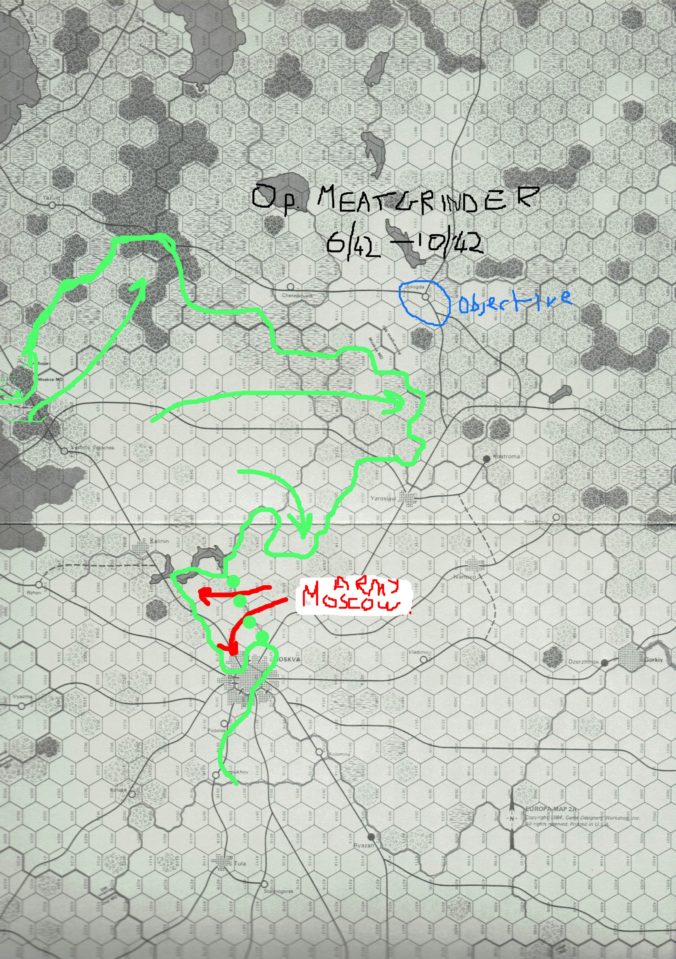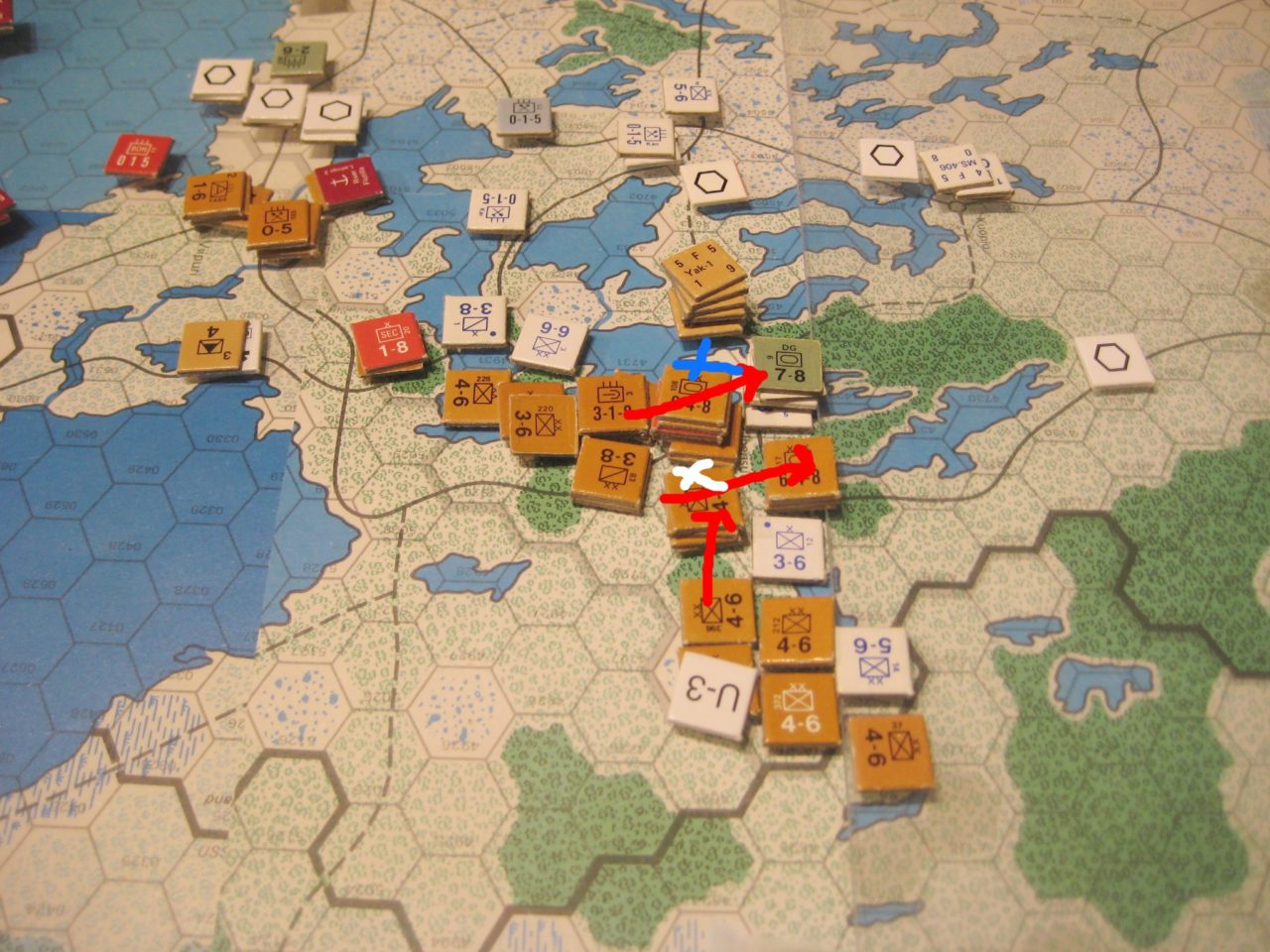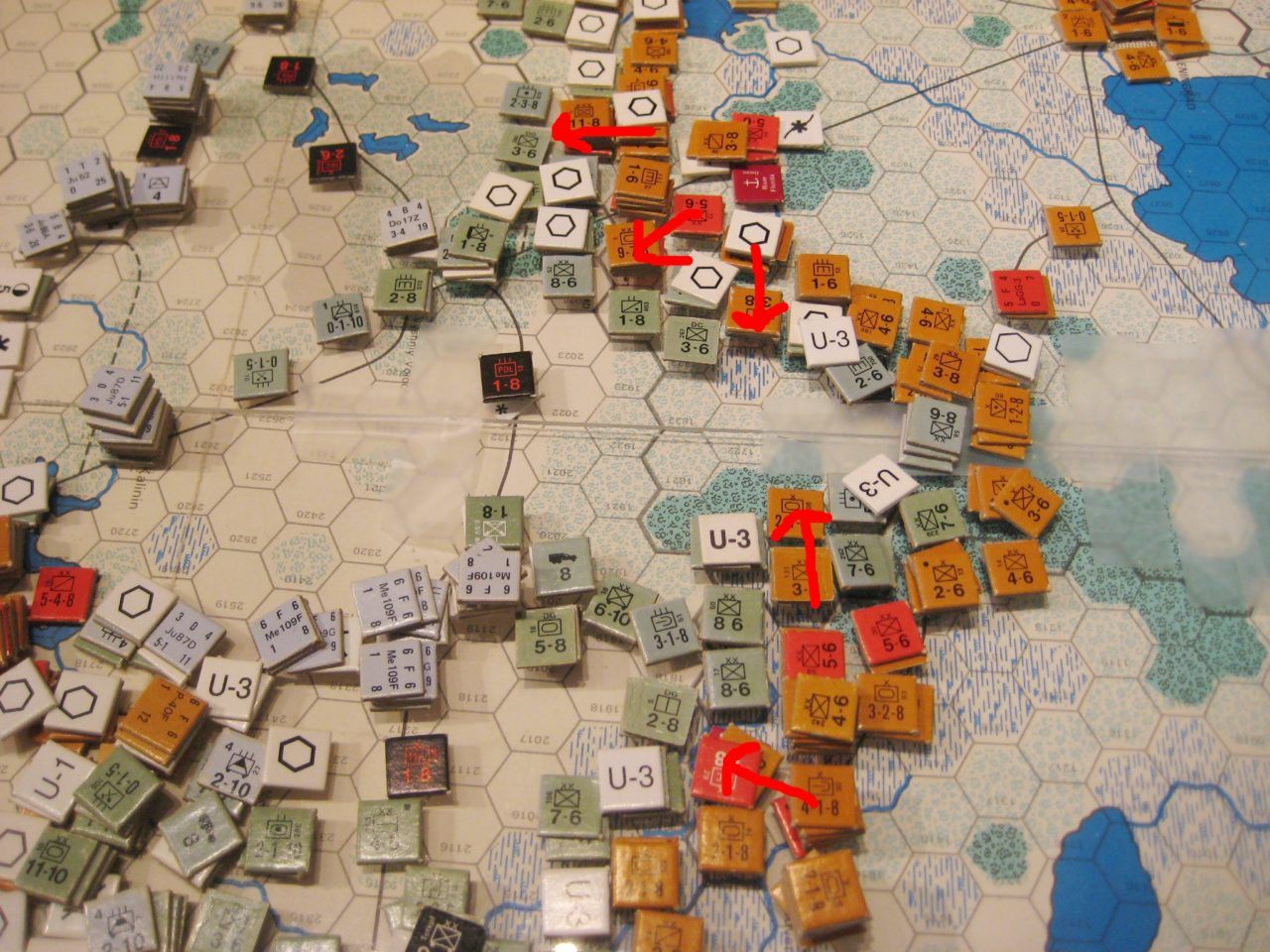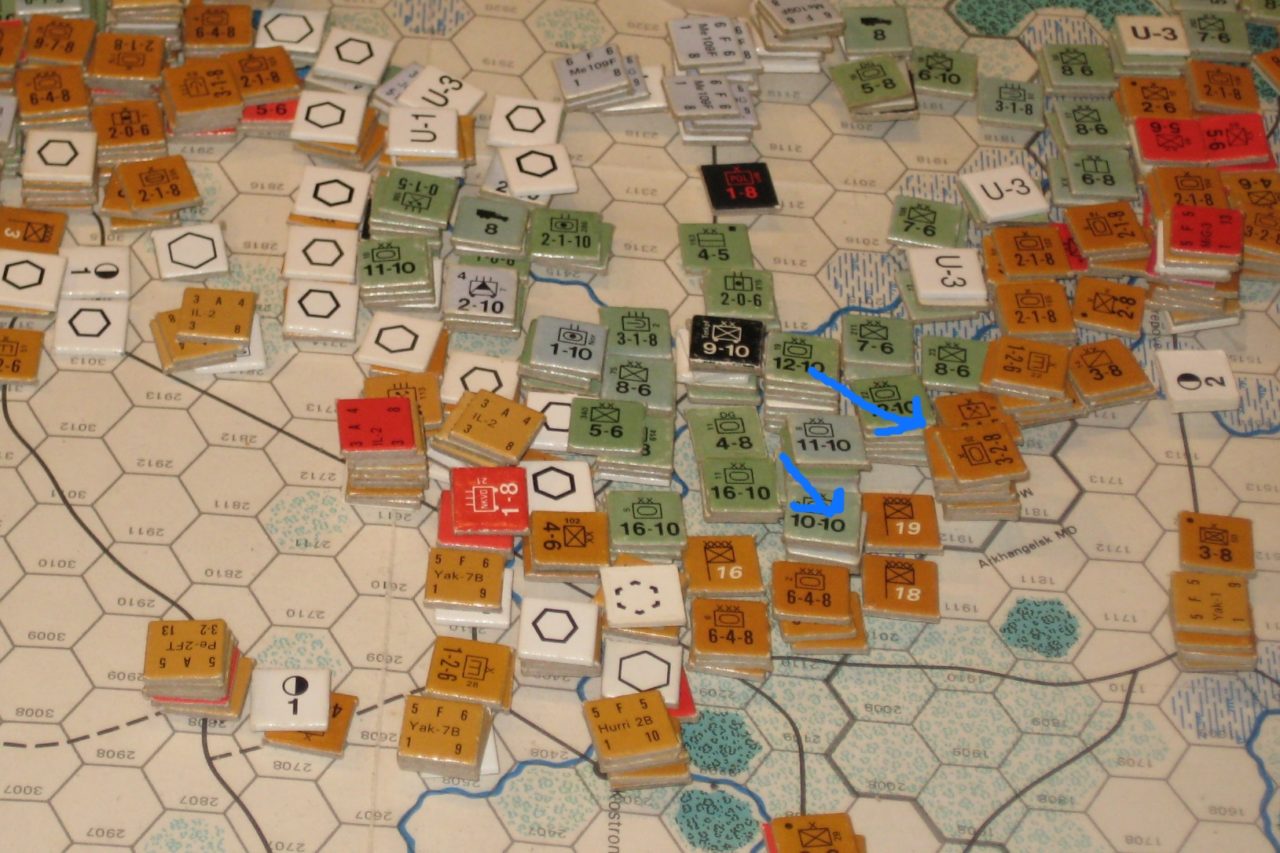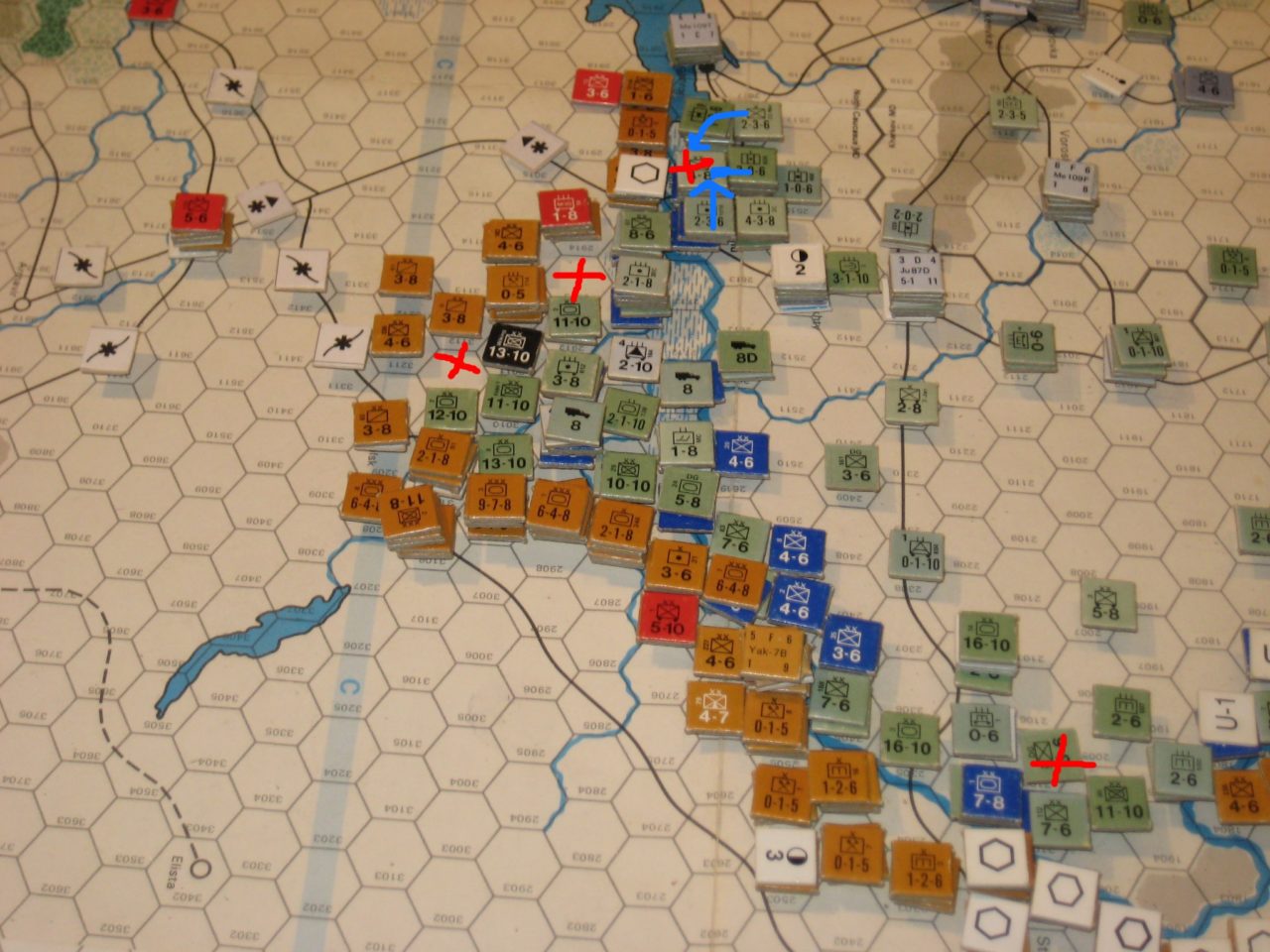The Axis force other than a final(?) spasm North of Moscow are now in a defensive posture and withdrawing in places on both of the major fronts. This therefore would seem a good point to review this campaigning year’s progress.
The Axis
The Axis plan was to isolate Leningrad from the rest of the country and through isolation ensure the fall of the city and elimination of all Soviet forces in the north and Finland. To this this they embarked on two separate (and diverging) objectives.
In the north the main thrust codenamed “Meatgrinder” was to capture by a single direct thrust the city of Vologda which occupies the vital rail junction between the East and Leningrad/Archangelsk
The southern attack codenamed “Fishhook” had Rostov as its territorial objective but was primarily designed to eliminate Soviet troops and tie up reserves and Soviet tank assets keeping them from engaging in the north.
At one point it looked as if Meatgrinder would succeed. Although Vologda was never directly threatened the junction at point 2197 was occupied (ever so briefly) and Leningrad was placed out of supply on a couple of occasions. However a Soviet counter attack managed to encircle the advancing German column and they were forced to retreat losing some panzers along the way. Since that highpoint the Germans have repeatedly demonstrated that where they mass they can advance The Soviets for their turn have demonstrated an amazing ability to recover and fight back. So whereas the Germans have steadily advanced it has been at a snail’s pace and the winter rains now restrict any breakout opportunities.
Even in the face of this advance the Soviets were confident enough to strip away their best assets and launch their own (limited) counter attack North of Moscow which has resulted in the re-capture of a Moscow hex and the occupation of the Kalinin/Moscow rail line the consequences of which are still unfolding.
One small aside was the ill-fated attempt by a single panzer corps to drive directly NE from Moscow and try to flank the Soviet defence of the Upper Volga. This unit found itself cut off and made a fighting advance to the safety of its own lines to the NE. What was notable here is that this showed how, if determined and fed with reinforcements the Soviets could hold onto territory and were capable of local counter attacks against German front line units. One hex in particular requires mention. That is the fortified position at 2616. This has held out throughout the campaign despite actual and considered attacks and has held steadfast as a bulwark against German attempts to clear a corridor along the East bank of the Upper Volga Indeed it could be said its defiance has facilitated the Soviet counter attack at Moscow to succeed for without this the flanks would have been more vulnerable to counter attack.
By any measure therefore “Meatgrinder” has failed in its objective.

The Northern Front in 1942
By contrast in the south operation Fishhook achieved all of its objectives but not exactly as planned and demonstrated a classic error of the German command to maintain a momentum of mass aimed at the prime objective.
Initially the plan worked like clockwork; numerous penetrations of the Soviet fortified line between Stalino and Voronezh were made and the resulting encirclement battles at the frontier killed hundreds of points of Soviets. Their mobile reserves were drawn into battle and a number eliminated. The Axis forces then advanced rapidly into the great bend of the River Don and were careful to maintain their objective as Rostov rather than be diverted to Stalingrad en mass which was a tempting fruit.
However they did then make a strategic error. They believed that a small expeditionary attack across the Don just south of Stalingrad would block reinforcements and tie up Soviet relief forces heading to engage their main bridgehead across the Don 100 miles east of Rostov. Thus a small number of panzers moved across the Don just south of Stalingrad. They did briefly staunch the flow of reinforcements but were quickly surrounded in turn. These forces then had to endure a fighting withdrawal back over the river.
(The Soviet’s own ill prepared counterattack into the bend of the river added complications but was dealt with promptly and efficiently.)
Ultimately however the splitting of the forces proved more of a hindrance to the Axis than any benefit it gained them. The diversion of forces rendered the main thrust aimed at isolating Rostov and forcing surrender by encirclement moribund. Soviet reinforcements from the deep south hemmed in the Axis bridgehead which did not now have enough strength the engage these new troops. The bridgehead was forced to halt its expansion until infantry and the troops from the Stalingrad region could be brought to bear. Due to two river crossings and a limited road network the latter took far too long and much longer than the Soviets re-deployment along the SE bank of the river where they engaged the main bridgehead while the panzers were still struggling back over the Don.
In the end Rostov was taken by direct assault but too few Soviets were eliminated in this second phase of the operation and crucially the dissipated German armour was not strong enough to confront the Soviet tanks who are now pressing against the bridgehead and harrying the retreat.
The larger question isthis; Did OKW made a similar mistake in their Grand Strategy by splitting their forces north and south and running Fishhook at all?
Would the Axis have been better to have put all their assets in the north? If they had done so it is quite likely Leningrad could have been isolated for a period but the Soviets unchecked in the south may well have launched a counter offensive of their own or more likely transferred many more troops and mobile assets against the Germans in the north. This is a question that will never definitively be known all we do know is that the Germans have failed in the north and at the time of writing they are themselves now under dire threat of encirclement.
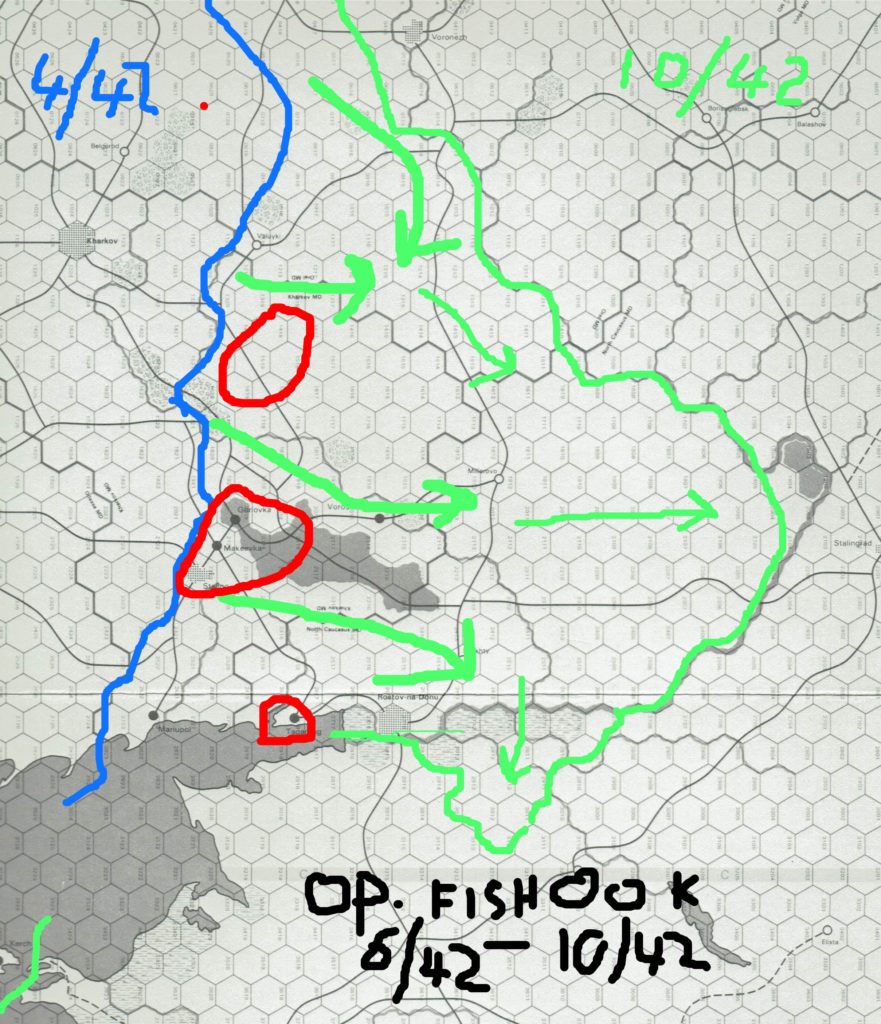
The Southern Front in 1942
The Soviets
The Soviets are generally pleased with the position at the moment. It is true that it was a dire failure to react to the German breakout at Kalinin in late ’41 that put them under so much pressure in the north but given that start they have much to be pleased about their current status.
They have for all practical purposes stabilised the line and have just launched their own winter offensive in the north.
Throughout the year although there were some early German breakthroughs in the north they organised their defence well with AT units strong armour units and managed after a while to pull back their armour assets into reserve. They do not fear the German strength now in the north. Furthermore they have through continued local counter attacks caused numerous casualties amongst the enemy armour. Their own attack north of Moscow has proven a good diversion from the main front and the recapture of a Moscow hex an added bonus.
Throughout the entire campaign despite the Axis actions in the south they have not diverted masses of troops south from this sector but managed to maintain just a sufficient amount for the job in hand.
In the south the Axis attack was initially devastating encircling many frontier forces and eliminating many more in the subsequent pursuit. The Soviets did organise a well executed credible mobile defence to contain the Axis initial attack but their own counter attack inflicted only minimal damage to the enemy. Despite some losses they managed to withdraw most of their armour East of the Don and maintain a defensive reserve.
The defence of Rostov went as well as could be expected. The city itself fell but the Soviets have extracted considerable losses to the Axis mobile forces in the battles east of the Don.
Their own foray across the Don was however quite disastrous. Too few forces sallied West to attempt to trap the Germans across the river at Stalingrad but they were immediately and expertly dispatched by the Axis forces and Soviet command in the south has been far more cautious since preferring to mass and husbanding the remaining tank assets,
As far as drawing off troops which could have been used in the North the Soviets in the south did not call for many such assets north of Tula. They did use many of the reserves south of Tula and a few reinforcements were diverted south but throughout the campaign the Soviets have generally been masters of committing just the right amount of troops to a given situation. Not too much and not too little
Overall then the STAVKA are pleased with the conduct of their forces in ’42.
Currently they hope their new offensive will cut off all German forces in the region Kalinin/Moscow/Vologda and they can deal a deadly blow to their foe.
The Germans however have shown themselves repeatedly to be good in a crisis and strong mobile assets from the south will soon arrive to bolster the faltering northern forces so only time will tell how this next phase will develop.
Air War
Time and again the Germans have shown their mastery of the air. When the Soviets can mass they are able to achieve some local success but every time they mount a large offensive operation or engage the Germans head on the German technical superiority shows resulting in the loss of Soviet aircraft which are no march one-for–one against the German machines.
